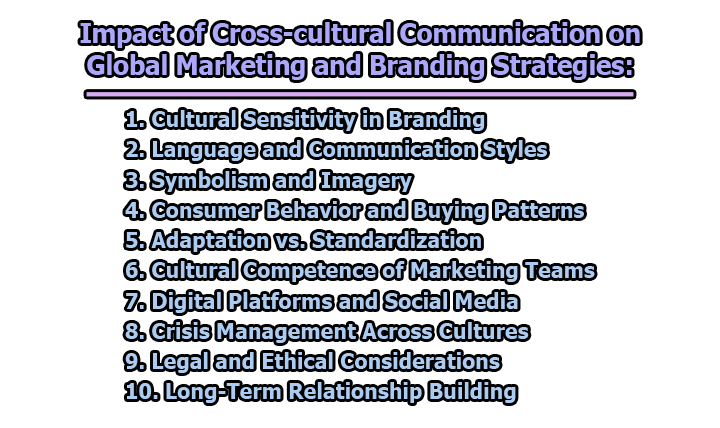Impact of Cross-cultural Communication on Global Marketing and Branding Strategies:
In an era of interconnected economies and digital globalization, businesses are increasingly expanding their horizons to tap into diverse markets worldwide. However, the success of global marketing and branding strategies hinges on effective cross-cultural communication. Understanding and navigating the intricacies of different cultures is paramount for businesses aiming to establish a meaningful presence in international markets. In this article, we delve into the impact of cross-cultural communication on global marketing and branding strategies.
1. Cultural Sensitivity in Branding: Cultural sensitivity in branding is a critical factor influencing the success of global marketing efforts. Brands that demonstrate an understanding and appreciation of local cultures are more likely to resonate with their target audiences. As Gudykunst and Kim (2003) assert, “Cultural sensitivity involves recognizing and respecting the values, beliefs, customs, and norms of a particular culture” (p. 87). Adapting branding strategies to align with these cultural elements helps create a more authentic and relatable brand image.
Furthermore, according to Holt et al. (2004), brands that exhibit cultural sensitivity in their messaging are perceived as more trustworthy and are better positioned to build lasting connections with consumers from diverse cultural backgrounds. This implies that a one-size-fits-all approach to branding is not effective in the global marketplace; instead, brands must be agile in tailoring their image to match the cultural preferences of specific markets.
2. Language and Communication Styles: Language is a powerful tool in global marketing, extending beyond mere translation. The nuances of language, including idioms, expressions, and communication styles, significantly impact how messages are received by different cultural groups (Gudykunst & Ting-Toomey, 1988). Effective cross-cultural communication in marketing involves not only linguistic accuracy but also an understanding of the cultural context in which the language is used.
For instance, when Coca-Cola expanded into the Chinese market, the company faced challenges related to linguistic nuances. The transliteration of “Coca-Cola” into Chinese initially sounded like “Bite the Wax Tadpole,” which held no appeal for consumers. Through a careful understanding of the language and cultural context, the brand adjusted its approach to create a phonetically appropriate and culturally resonant name, contributing to its success in the Chinese market (Gregory, 2003).
3. Symbolism and Imagery: The use of symbols and imagery in global marketing demands a nuanced understanding of cultural variations to avoid unintentional misinterpretations. Different cultures ascribe varied meanings to symbols, colors, and images, making it crucial for brands to navigate this landscape carefully. According to Usunier and Lee (2005), “The same visual element can evoke entirely different emotions or associations in diverse cultural contexts” (p. 112). As such, a symbol that may be innocuous or positive in one culture might carry negative connotations in another.
For example, the color white symbolizes purity and weddings in Western cultures, but it signifies mourning in some Asian cultures. Understanding these variations is imperative for global brands to avoid unintentional cultural insensitivity. This highlights the importance of conducting thorough cultural research and testing visual elements across different markets to ensure that symbols and imagery align with the intended message and do not inadvertently offend or alienate the target audience.
4. Consumer Behavior and Buying Patterns: Cross-cultural communication extends beyond language and symbolism to encompass an in-depth understanding of consumer behavior and buying patterns. Different cultures have distinct approaches to decision-making, influenced by factors such as collectivism, individualism, uncertainty avoidance, and power distance (Hofstede, 1980). Marketers must recognize these cultural dimensions to tailor their strategies effectively.
For instance, in cultures characterized by high uncertainty avoidance, consumers may prefer familiar and well-established brands, emphasizing the importance of building trust and credibility. In contrast, individualistic cultures may prioritize personal preferences and individual needs, necessitating marketing messages that appeal to personal aspirations and uniqueness.
By aligning marketing strategies with cultural insights into consumer behavior, brands can develop campaigns that not only resonate with their target audience but also influence purchasing decisions in a culturally relevant manner. Understanding these nuances is essential for creating impactful global marketing strategies that go beyond surface-level cultural adaptations.
5. Adaptation vs. Standardization: Balancing adaptation and standardization is a crucial consideration in global marketing strategies. The approach a brand takes must be flexible enough to accommodate cultural differences while maintaining a consistent global brand image. According to Jain (1989), “The challenge lies in finding the right equilibrium between standardized global marketing strategies for cost efficiency and adapted strategies that resonate with local cultures” (p. 47). Striking this balance is essential for ensuring that the brand remains relevant and appealing across diverse markets.
Brands that lean too heavily towards standardization risk overlooking local nuances and may fail to connect with the specific needs and values of individual cultures. On the other hand, excessive adaptation can dilute the global brand identity and erode the familiarity that often contributes to a brand’s success. Successful global brands, such as McDonald’s and Coca-Cola, strategically balance standardized elements, like logos and core brand messages, with localized marketing campaigns that reflect cultural preferences (Levitt, 1983).
Achieving the right balance requires a deep understanding of each market’s cultural intricacies, consumer behaviors, and preferences. By adopting a nuanced approach, brands can position themselves to effectively navigate the tension between adaptation and standardization, maximizing global appeal while maintaining cultural relevance.
6. Cultural Competence of Marketing Teams: Building a culturally competent marketing team is fundamental for the success of global marketing efforts. A diverse and culturally aware team brings a wealth of perspectives and insights, enhancing the creativity and effectiveness of marketing strategies. As Brislin (1981) notes, “Cultural competence involves not only knowledge of different cultures but also the ability to adapt and interact effectively across cultural boundaries” (p. 21). This adaptability is crucial in crafting messages that resonate authentically with diverse audiences.
A culturally competent team understands the nuances of communication, appreciates cultural sensitivities, and can identify potential pitfalls that may arise in cross-cultural campaigns. This cultural intelligence is not only valuable in creating initial marketing strategies but also in adapting campaigns based on ongoing feedback and cultural dynamics.
Moreover, a diverse team can bring a deep understanding of local markets, facilitating the development of culturally relevant content and strategies. By investing in the cultural competence of their marketing teams, companies position themselves to navigate the complexities of global marketing with agility and effectiveness.
7. Digital Platforms and Social Media: In the age of digital interconnectedness, cross-cultural communication in global marketing extends to the diverse landscape of digital platforms and social media. Different cultures engage with online content in unique ways, and brands must adapt their strategies accordingly. As Tuten and Solomon (2017) highlight, “Understanding the cultural nuances of each digital platform is essential for creating content that resonates with users from diverse cultural backgrounds” (p. 231). Social media platforms, for instance, have distinct usage patterns and cultural norms that influence user interactions.
Brands need to be cognizant of these nuances to craft content that is not only culturally sensitive but also aligns with the expectations of users on specific platforms. This requires a deep understanding of the cultural context in which digital interactions take place, including the role of influencers, the use of visual elements, and the appropriateness of certain types of content.
Additionally, social media provides a direct channel for two-way communication, enabling brands to receive immediate feedback from their global audience. This real-time interaction demands cultural responsiveness and the ability to adapt strategies swiftly based on audience reactions, ensuring that brands maintain a positive online presence across diverse cultural contexts.
8. Crisis Management Across Cultures: Crisis management in global marketing necessitates a keen understanding of cultural responses to unexpected events. Different cultures may react to crises differently, and what may be an appropriate crisis communication strategy in one culture could be perceived differently in another. According to Fukukawa and Moon (2004), “Cultural differences in communication styles, expression of emotions, and crisis perception can significantly impact the effectiveness of crisis management strategies” (p. 78).
For instance, a crisis that requires a transparent and direct communication style in one culture may demand a more indirect and empathetic approach in another. Understanding cultural nuances in crisis communication is crucial for maintaining brand integrity and trust across diverse markets.
Moreover, being prepared for potential crises requires proactive planning that takes into account the cultural landscapes of various markets. This includes understanding how different cultures perceive responsibility, accountability, and transparency, and tailoring crisis management strategies accordingly. By incorporating cultural considerations into crisis communication plans, brands can navigate challenging situations with cultural sensitivity, mitigating potential negative impacts on their global reputation.
9. Legal and Ethical Considerations: Cross-cultural communication in global marketing involves navigating diverse legal and ethical landscapes. What may be considered acceptable and lawful in one country could be perceived differently or even prohibited in another. It is crucial for global brands to adhere to local regulations and ethical standards to ensure the sustainability of their marketing and branding efforts (Czinkota et al., 2009).
Legal considerations encompass a range of factors, including advertising standards, data protection laws, and product labeling requirements. Adhering to these regulations is not only a legal necessity but also a demonstration of respect for the local culture and its governing authorities. Failure to do so can result in legal consequences, damage to the brand’s reputation, and a loss of consumer trust.
Ethical considerations, on the other hand, involve aligning marketing practices with the moral values of each culture. This requires an understanding of cultural norms related to issues such as gender representation, environmental sustainability, and fair labor practices. Brands that prioritize ethical considerations in their global marketing strategies not only foster positive relationships with consumers but also contribute to the establishment of a socially responsible global brand image.
10. Long-Term Relationship Building: Global marketing success is not solely about short-term gains; it hinges on the ability to build long-term relationships with diverse audiences. Cultural sensitivity plays a crucial role in fostering trust, loyalty, and positive brand perceptions over time. As Kotler and Keller (2016) emphasize, “Successful global brands invest in building enduring relationships by consistently delivering value that aligns with the cultural expectations and preferences of their target audiences” (p. 482).
Establishing long-term relationships requires ongoing engagement and communication. Brands need to stay attuned to cultural shifts, evolving consumer preferences, and changes in the competitive landscape. This involves maintaining an open line of communication with consumers through various channels, including social media, customer feedback mechanisms, and localized marketing campaigns.
By prioritizing long-term relationship building, brands position themselves to adapt to changing cultural dynamics and continue resonating with their global audience. This commitment to sustained cultural relevance contributes to the longevity and success of global marketing and branding strategies.
In conclusion, the impact of cross-cultural communication on global marketing and branding strategies cannot be overstated. Businesses that prioritize cultural understanding, language nuances, and adaptation to diverse consumer behaviors are better positioned to thrive in the complex landscape of international markets. By embracing the richness of global diversity, brands can create meaningful connections, foster brand loyalty, and ultimately achieve sustainable success on a global scale.
References:
- Brislin, R. W. (1981). Cross-cultural encounters: Face-to-face interaction.
- Czinkota, M. R., Ronkainen, I. A., & Moffett, M. H. (2009). International business. John Wiley & Sons.
- Fukukawa, K., & Moon, J. (2004). A cross-cultural comparison of ethical attitudes of business managers: India Korea, and the United States. Journal of Business Ethics, 54(4), 323–337.
- Gregory, K. (2003). The Coca-Cola brand in China: A cultural exploration. Journal of Global Marketing, 17(2-3), 111–132. https://doi.org/10.1300/J042v17n02_07
- Gudykunst, W. B., & Kim, Y. Y. (2003). Communicating with strangers: An approach to intercultural communication. McGraw-Hill.
- Gudykunst, W. B., & Ting-Toomey, S. (1988). Culture and interpersonal communication. Sage Publications.
- Hofstede, G. (1980). Culture’s consequences: International differences in work-related values. Sage Publications.
- Holt, D. B., Quelch, J. A., & Taylor, E. L. (2004). How global brands compete. Harvard Business Review, 82(9), 68–75.
- Jain, S. C. (1989). Standardization of international marketing strategy: Some research hypotheses. Journal of Marketing, 53(1), 70–79. https://doi.org/10.1177/002224298905300109
- Kotler, P., & Keller, K. L. (2016). Marketing management (15th ed.). Pearson.
- Levitt, T. (1983). The globalization of markets. Harvard Business Review, 61(3), 92–102.
- Tuten, T. L., & Solomon, M. R. (2017). Social media marketing. Sage Publications.
- Usunier, J. C., & Lee, J. A. (2005). Marketing across cultures (4th ed.). Pearson.

Library Lecturer at Nurul Amin Degree College










